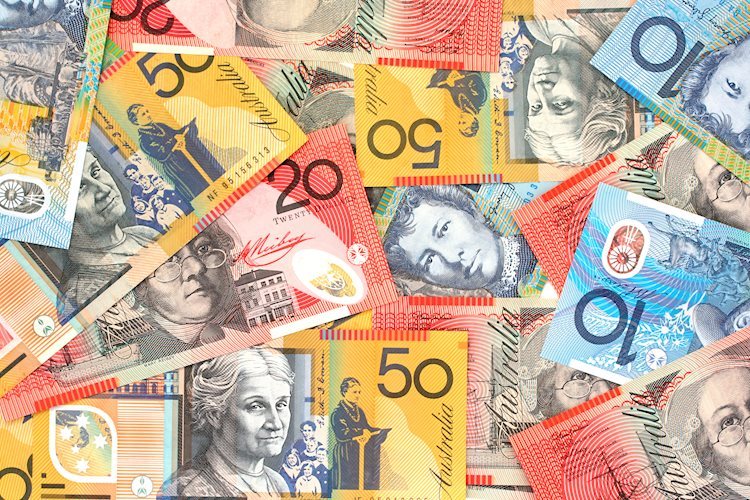- The Australian Dollar declines as the ANZ now forecasts a 25 basis points rate cut by the RBA in February.
- China’s latest inflation data, which underscored rising deflationary risks, offered no support to the AUD.
- The US Dollar continues to receive support following the latest hawkish FOMC Meeting Minutes.
The Australian Dollar (AUD) extends its losses for the fourth consecutive day against the US Dollar (USD), with the AUD/USD pair hovering near two-year lows on Friday. The AUD receives downward pressure as the ANZ is now forecasting a 25 basis points (bps) rate cut by the Reserve Bank of Australia (RBA) in February. Traders are now focused on US labor market data including Nonfarm Payrolls (NFP), for additional policy direction insights.
The AUD found no support from China’s latest inflation data, which highlighted increasing deflationary risks. China’s Consumer Price Index (CPI) increased by 0.1% year-over-year in December, slightly lower than the 0.2% rise in November, matching market expectations. Monthly, CPI inflation remained unchanged at 0% in December, aligning with estimates, following a 0.6% decline in November. Any change in Chinese economic conditions could impact the Australian markets as both nations are close trading partners.
Traders digested data showing Australia’s Retail Sales, a key indicator of consumer spending, increased by 0.8% month-on-month in November, up from the 0.5% growth recorded in October (revised from 0.6%). However, the figure fell short of market expectations, which had anticipated a 1.0% rise.
The Australian Dollar faced challenges as the trimmed mean, a closely watched measure of core inflation, fell to an annual 3.2% from 3.5%, edging closer to the Reserve Bank of Australia’s (RBA) target band of 2% to 3%. Markets are currently divided on whether the RBA will act in February, but a quarter-point rate cut in April is fully priced in.
Australian Dollar continues to decline amid increased hawkish mood surrounding Fed
- The US Dollar Index (DXY), which tracks the US Dollar’s (USD) performance against six major currencies, remains steady above 109.00. The Greenback gained support from hawkish Federal Open Market Committee (FOMC) Meeting Minutes and uncertainties surrounding tariff plans proposed by the incoming Trump administration.
- The latest FOMC Meeting Minutes indicated that policymakers agree that the process could take longer than previously anticipated due to recent hotter-than-expected readings on inflation and the effects of potential changes in trade and immigration policy under President-elect Trump’s administration.
- Federal Reserve Board of Governors member Michelle Bowman added her voice to a chorus of Fed speakers this week as policymakers work double-duty to try and smooth over market reactions to a much tighter pace of rate cuts in 2025 than many market participants had previously anticipated.
- Kansas Fed President Jeffrey Schmid made headlines on Thursday, stating that most of the Federal Reserve’s mandated targets have recently been achieved. Schmid emphasized the need to reduce the Fed’s balance sheet, suggesting that interest rate policy is approaching its long-term equilibrium. He noted that any future rate cuts should be gradual and guided by economic data.
- US Initial Jobless Claims fell to 201,000 for the week ending January 3, beating the 218,000 consensus. ADP Employment Change rose by 122K in December, though below market expectations of 140K.
- The US ISM Services PMI increased to 54.1 in November, up from 52.1, exceeding the market expectation of 53.3. The Prices Paid Index, which reflects inflation, rose significantly to 64.4 from 58.2, while the Employment Index dipped slightly to 51.4 from 51.5.
- According to Bloomberg, Federal Reserve Bank of Atlanta President Raphael Bostic stated on Tuesday that Fed officials should exercise caution with policy decisions due to uneven progress in reducing inflation. Bostic emphasized the need to lean toward keeping interest rates elevated to ensure the achievement of price stability goals.
- Richmond Fed President Thomas Barkin highlighted on Friday that the benchmark policy rate should remain restrictive until there is greater confidence that inflation will return to the 2% target. Meanwhile, Fed Governor Adriana Kugler and San Francisco Fed President Mary Daly underscored the challenging balancing act facing US central bankers as they aim to slow the pace of monetary easing this year.
- Australia’s trade surplus rose to 7,079 million in November, surpassing the expected 5,750 million and the previous reading of 5,670 million (revised from 5,953 million). Exports increased by 4.8% month-on-month (MoM) in November, up from 3.5% (revised from 3.6%) in October. Meanwhile, imports grew by 1.7% MoM in November, compared to 0% (revised from 0.1%) in the previous month.
- Australia’s monthly Consumer Price Index (CPI) rose 2.3% year-over-year in November, surpassing the market forecast of 2.2% and marking an increase from the 2.1% rise seen in the previous two months. This is the highest reading since August. However, the figure remains within the RBA’s target range of 2–3% for the fourth consecutive month, aided by the ongoing impact of the Energy Bill Relief Fund rebate.
Technical Analysis: Australian Dollar remains above 0.6200 near nine-day EMA
AUD/USD trades near 0.6200 on Friday, maintaining a bearish tone as it stays within a descending channel on the daily chart. The 14-day Relative Strength Index (RSI) hovers just above 30, indicating a risk of heightened bearish momentum.
Regarding its support, the AUD/USD pair could approach the lower boundary of the descending channel around the 0.5960 level.
The immediate resistance is seen near the nine-day Exponential Moving Average (EMA) at 0.6216, followed by the 14-day EMA at 0.6230. A stronger resistance level lies near the upper boundary of the descending channel, around 0.6240.
AUD/USD: Daily Chart
Australian Dollar PRICE Today
The table below shows the percentage change of Australian Dollar (AUD) against listed major currencies today. Australian Dollar was the weakest against the Swiss Franc.
| USD | EUR | GBP | JPY | CAD | AUD | NZD | CHF | |
|---|---|---|---|---|---|---|---|---|
| USD | 0.01% | 0.08% | 0.05% | 0.10% | -0.01% | 0.03% | -0.03% | |
| EUR | -0.01% | 0.07% | 0.02% | 0.08% | -0.02% | 0.01% | -0.04% | |
| GBP | -0.08% | -0.07% | -0.02% | 0.02% | -0.09% | -0.05% | -0.11% | |
| JPY | -0.05% | -0.02% | 0.02% | 0.05% | -0.05% | -0.03% | -0.07% | |
| CAD | -0.10% | -0.08% | -0.02% | -0.05% | -0.11% | -0.06% | -0.13% | |
| AUD | 0.00% | 0.02% | 0.09% | 0.05% | 0.11% | 0.04% | -0.02% | |
| NZD | -0.03% | -0.01% | 0.05% | 0.03% | 0.06% | -0.04% | -0.06% | |
| CHF | 0.03% | 0.04% | 0.11% | 0.07% | 0.13% | 0.02% | 0.06% |
The heat map shows percentage changes of major currencies against each other. The base currency is picked from the left column, while the quote currency is picked from the top row. For example, if you pick the Australian Dollar from the left column and move along the horizontal line to the US Dollar, the percentage change displayed in the box will represent AUD (base)/USD (quote).
RBA FAQs
The Reserve Bank of Australia (RBA) sets interest rates and manages monetary policy for Australia. Decisions are made by a board of governors at 11 meetings a year and ad hoc emergency meetings as required. The RBA’s primary mandate is to maintain price stability, which means an inflation rate of 2-3%, but also “..to contribute to the stability of the currency, full employment, and the economic prosperity and welfare of the Australian people.” Its main tool for achieving this is by raising or lowering interest rates. Relatively high interest rates will strengthen the Australian Dollar (AUD) and vice versa. Other RBA tools include quantitative easing and tightening.
While inflation had always traditionally been thought of as a negative factor for currencies since it lowers the value of money in general, the opposite has actually been the case in modern times with the relaxation of cross-border capital controls. Moderately higher inflation now tends to lead central banks to put up their interest rates, which in turn has the effect of attracting more capital inflows from global investors seeking a lucrative place to keep their money. This increases demand for the local currency, which in the case of Australia is the Aussie Dollar.
Macroeconomic data gauges the health of an economy and can have an impact on the value of its currency. Investors prefer to invest their capital in economies that are safe and growing rather than precarious and shrinking. Greater capital inflows increase the aggregate demand and value of the domestic currency. Classic indicators, such as GDP, Manufacturing and Services PMIs, employment, and consumer sentiment surveys can influence AUD. A strong economy may encourage the Reserve Bank of Australia to put up interest rates, also supporting AUD.
Quantitative Easing (QE) is a tool used in extreme situations when lowering interest rates is not enough to restore the flow of credit in the economy. QE is the process by which the Reserve Bank of Australia (RBA) prints Australian Dollars (AUD) for the purpose of buying assets – usually government or corporate bonds – from financial institutions, thereby providing them with much-needed liquidity. QE usually results in a weaker AUD.
Quantitative tightening (QT) is the reverse of QE. It is undertaken after QE when an economic recovery is underway and inflation starts rising. Whilst in QE the Reserve Bank of Australia (RBA) purchases government and corporate bonds from financial institutions to provide them with liquidity, in QT the RBA stops buying more assets, and stops reinvesting the principal maturing on the bonds it already holds. It would be positive (or bullish) for the Australian Dollar.
Read the full article here















